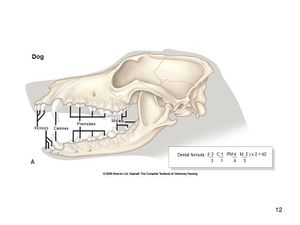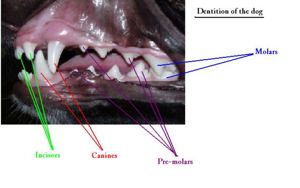Difference between revisions of "Dental Formula - Dog"
Fiorecastro (talk | contribs) |
|||
| (21 intermediate revisions by 4 users not shown) | |||
| Line 3: | Line 3: | ||
[[Image:Aspinall Slide12.JPG|thumb|right|300px|<small>Image from [http://www.elsevierhealth.co.uk/veterinary-nursing/spe-60136/ Aspinall, The Complete Textbook of Veterinary Nursing], Elsevier Health Sciences, ''All rights reserved''</small>]] | [[Image:Aspinall Slide12.JPG|thumb|right|300px|<small>Image from [http://www.elsevierhealth.co.uk/veterinary-nursing/spe-60136/ Aspinall, The Complete Textbook of Veterinary Nursing], Elsevier Health Sciences, ''All rights reserved''</small>]] | ||
| − | Dogs are toothless at birth. | + | Dogs are toothless at birth. Their '''deciduous''' teeth are complete and functional within 2 months of birth. '''Permanent''' teeth are complete and funtional by the end of the 6th or 7th month. |
| − | + | The formula for '''deciduous''' teeth: 2 (I3/3 C1/1 P3/3) | |
| − | + | The formula for '''permanent''' teeth: 2 (I3/3 C1/1 P4/4 M2/3) | |
| − | === | + | ===Canines=== |
| − | |||
| − | + | The canines are large, curved and laterally compressed. Their [[Enamel Organ#Root|root]] is longer than their [[Enamel Organ#Crown|crown]]. They have a single [[Enamel Organ#Root|root]]. | |
| − | The | ||
| − | + | [[Image:Dog Dentition.jpg|thumb|right|300px|Dog Dentition - Copyright Nottingham 2008]] | |
| − | |||
===Molars=== | ===Molars=== | ||
| − | |||
| − | == | + | The molars are broader than the premolars. The number of cusps is similar in all breeds, usually two or three. |
| + | |||
| + | ===Incisors=== | ||
| + | |||
| + | The incisors are '''tricuspid''' in the upper jaw and '''bicuspid''' in lower jaw. They are smaller rostrally and have a single [[Enamel Organ#Root|root]]. | ||
| + | |||
| + | ===Premolars=== | ||
| − | + | The premolars are irregular and closely-spaced. They are more complex and larger caudally. They have a discontinuous cutting edge on [[Enamel Organ#Crown|crowns]]. | |
| − | |||
| − | |||
| − | |||
| − | |||
| + | ==Breed Differences== | ||
| − | + | Eruption times differ between breeds so it is difficult to age dogs by their teeth. '''Brachiocephalic''' dogs do not possess all of the cheek teeth. They have '''fused [[Enamel Organ#Root|roots]]''' and '''carnasial teeth''' (upper P4 and lower M1). | |
| − | | | ||
| − | {{ | + | {{OpenPages}} |
| − | |||
| − | |||
[[Category:Teeth - Anatomy & Physiology]] | [[Category:Teeth - Anatomy & Physiology]] | ||
[[Category:Dog - Alimentary System]] | [[Category:Dog - Alimentary System]] | ||
| − | [[Category: | + | [[Category:A&P Done]] |
| − | [[Category: | + | [[Category:Dentistry]] |
| − | [[Category: | + | [[Category:LisaM reviewing]] |
Revision as of 15:10, 10 June 2013
Overview

Dogs are toothless at birth. Their deciduous teeth are complete and functional within 2 months of birth. Permanent teeth are complete and funtional by the end of the 6th or 7th month.
The formula for deciduous teeth: 2 (I3/3 C1/1 P3/3)
The formula for permanent teeth: 2 (I3/3 C1/1 P4/4 M2/3)
Canines
The canines are large, curved and laterally compressed. Their root is longer than their crown. They have a single root.
Molars
The molars are broader than the premolars. The number of cusps is similar in all breeds, usually two or three.
Incisors
The incisors are tricuspid in the upper jaw and bicuspid in lower jaw. They are smaller rostrally and have a single root.
Premolars
The premolars are irregular and closely-spaced. They are more complex and larger caudally. They have a discontinuous cutting edge on crowns.
Breed Differences
Eruption times differ between breeds so it is difficult to age dogs by their teeth. Brachiocephalic dogs do not possess all of the cheek teeth. They have fused roots and carnasial teeth (upper P4 and lower M1).
Error in widget FBRecommend: unable to write file /var/www/wikivet.net/extensions/Widgets/compiled_templates/wrt693d100995ace2_32561538 Error in widget google+: unable to write file /var/www/wikivet.net/extensions/Widgets/compiled_templates/wrt693d1009b89986_83610687 Error in widget TwitterTweet: unable to write file /var/www/wikivet.net/extensions/Widgets/compiled_templates/wrt693d1009d51214_34070898
|
| WikiVet® Introduction - Help WikiVet - Report a Problem |
